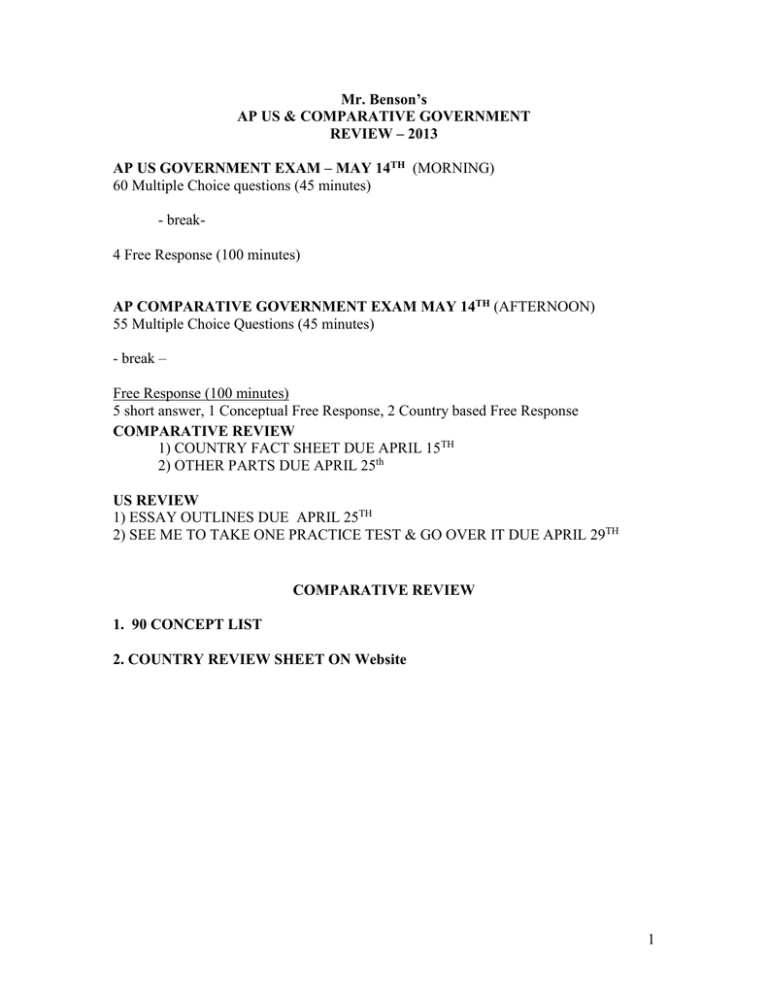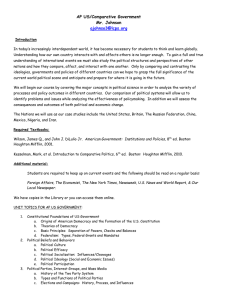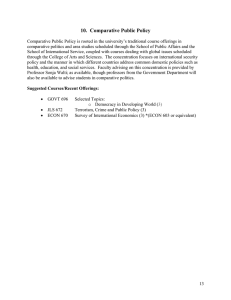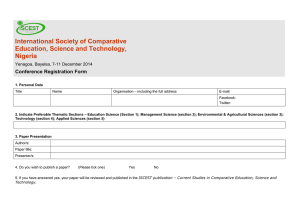60 Multiple Choice questions (45 minutes) - break-
advertisement

Mr. Benson’s AP US & COMPARATIVE GOVERNMENT REVIEW – 2013 AP US GOVERNMENT EXAM – MAY 14TH (MORNING) 60 Multiple Choice questions (45 minutes) - break4 Free Response (100 minutes) AP COMPARATIVE GOVERNMENT EXAM MAY 14TH (AFTERNOON) 55 Multiple Choice Questions (45 minutes) - break – Free Response (100 minutes) 5 short answer, 1 Conceptual Free Response, 2 Country based Free Response COMPARATIVE REVIEW 1) COUNTRY FACT SHEET DUE APRIL 15TH 2) OTHER PARTS DUE APRIL 25th US REVIEW 1) ESSAY OUTLINES DUE APRIL 25TH 2) SEE ME TO TAKE ONE PRACTICE TEST & GO OVER IT DUE APRIL 29TH COMPARATIVE REVIEW 1. 90 CONCEPT LIST 2. COUNTRY REVIEW SHEET ON Website 1 Name of Country ___________ Review Sheet Federal/Unitary # of subunits Presidential, Parliamentary or Mixed Head of State/Head of Government Name of Judicial Branch Name of Head of State (for example, President) Powers of Head of state, length of term Election process of Head of state, length of term Number of seats in Legislative Branch, length of term, describe power of legislative branch (rubber stamp, powerful) How are judges selected Bureaucracy/Cabinet Describe bureaucracy Political Recruitment Other important institutions (complete only if applicable to your country) Media How are elites recruited? Name of Legislative Branch (identify both houses if applicable) Legitimacy Features of Constitution Historical Evolution of Political Traditions Key Political Leaders and their policies Ethnic Cleavages Description of arrangement (for example devolution etc) Name of Head of Government Powers of Head of Government Election process of Head of Government Describe elections of legislative branch Describe type of power Describe cabinet Describe type of “feedback” How independent is the citizens receive media? Describe level of legitimacy Identify sources of legitimacy When was it written Identify 3 unique features (Identify three key events and briefly explain how the events shaped current government. (revolutions, for example) Identify and describe 3 (identify the major ethnic cleavages in the country) (describe the results of these cleavages in political conflict and government response, include a description of women) Political Parties (Id/describe platforms of three) 2 Role of Political Elites Citizens Interest Group System (identify pluralist or corporatist) Economic System (identify capitalist, socialist; Identify major economic policies government has adopted) First World/Third World Supranational Organizations Public Policy (identify elites (people with political power) and describe their role) Describe attitudes towards government Identify key interest groups Identify state owned industries, foreign owned industries, nature of privatization Describe types of political participation Describe their power and activities Describe major resources and state services such as oil, health care, education Describe level of economic development Identify 5 socioeconomic indicators that places the country in this category Identify supranational Discuss impact of organizations that country is supranational organizations a part of on sovereignty and on development Identify and describe three Identify and describe most recent policies pressing current problems Election Watch – Identify the most recent elections (national and local) and describe the results – see blackboard Current Events Each student in the group should choose one at least one current event article and describe them-see blackboard. For your chosen article, explain the relevance/significance to comparative politics. 3 Name _________ AP Comparative Government Key Terms & Concept Directions (1) Define each key concept. (2) Give one country specific example for each concept. Note: some of these concepts are not in your textbook! For definitions of these please refer to your classroom notes. 1. authoritarian rule 2. bonyads 3. bureaucracy 4. camarilla 5. catch all party 6. cleavages (ethnic) 7. civil service 8. civil society 9. (a) code law (b) common law 10. corporatism 11. charismatic authority 12. coup d’etat 13. command economy 14. communism 15. comparative method (country example not required – define and give a method) 16. constitution 17. (a) corporatism (b) pluralism 18. (a) correlation – (b) causation 19. democracy 20. democratic deficit 21. democratization 4 22. development 23. devolution 24. efficacy 25. electoral system 26. elite recruitment 27. failed state 28. federalism 29. first past the post 30. fragmentation 31. fusion of power 32. separation of power 33. GDP 34. gini index 35. glasnost 36. globalization 37. government 38. (a) head of government (b)head of state 39. illiberal democracy 40. industrialized democracy 41. iron triangle 42. judicial review 43. legitimacy 44. Marxism 45. mass line 46. military rule 47. micro credit 48. minimum winning threshold 49. mixed presidential parliamentary system 5 50. modernization 51. Multinational corporation (MNC) – 52. (a) multiparty system (b) two party system(c) one party system – (d) one party dominant system53. nation 54. newly industrializing countries 55. nomenklatura 56. non governmental organization (NGO) 57. oligarchy 58. parastatls 59. parliamentary system 60. patron client politics 61. perestroika 62. pluralism 63. plurality 64. politburo 65. political culture 66. political participation 67. political socialization 68. postmaterialism 69. presidential system 70. proportional representation 71. privatization 72. referendum 73. regime 74. rentier state 75. revolution 76. rule of law 6 77. shock therapy 78. single member districts 79. sovereignty 80. state 81. structural adjustment/import substitution 82. supranational organization 83. theocracy 84. third world 85. totalitarian 86. transparency 87. two party system 88. two ballot system 89. unitary state 90. vote of confidence 91. welfare state 92. ____________ 93. _____________ 94. ____________ 95. ____________ 96. ___________ 97. ___________ 98. ___________ 99. ____________ 100. ____________ 7




